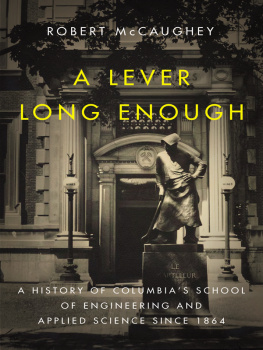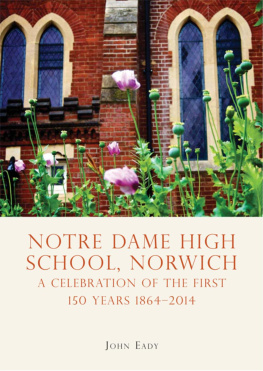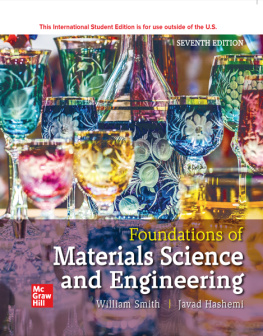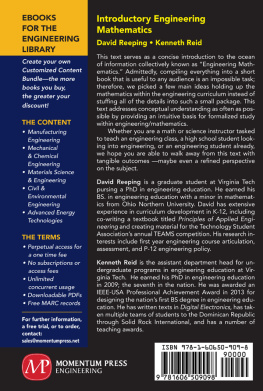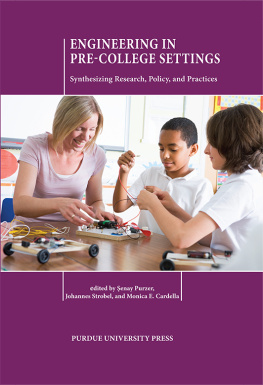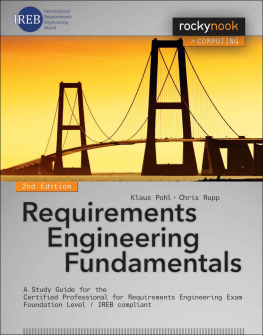A LEVER LONG ENOUGH
ROBERT McCAUGHEY
A LEVER LONG ENOUGH
A History of Columbias School of Engineering and Applied Science Since 1864
Columbia University Press / New York
Columbia University Press
Publishers Since 1893
New York Chichester, West Sussex
cup.columbia.edu
Copyright 2014 Columbia University Press
All rights reserved
E-ISBN: 978-0-231-53752-0
Library of Congress Cataloging-in-Publication Data
McCaughey, Robert A.
A lever long enough : a history of Columbias School of Engineering and Applied Science since 1864 / Rober McCaughey.
pages cm
ISBN 978-0-231-16688-1 (cloth : alk. paper) ISBN 978-0-231-53752-0 (ebook)
1. Fu Foundation School of Engineering and Applied ScienceHistory. I. Title.
T171.F854M33 2014
620.0071'17471dc23
2014007037
A Columbia University Press E-book.
CUP would be pleased to hear about your reading experience with this e-book at .
COVER DESIGN: Faceout Studio
COVER IMAGE: General Research Division, The New York Public Library, Astor, Lenox, and Tilden Foundations
References to websites (URLs) were accurate at the time of writing. Neither the author nor Columbia University Press is responsible for URLs that may have expired or changed since the manuscript was prepared.
To Ann, as always, to River and Bode, Wyatt and Fiona, and to Columbias engineers
Give me a lever long enough and somewhere to stand and I will move the world.
ARCHIMEDES (287212 B.C.)1
CONTENTS
F ROM ITS BEGINNING as Kings College in 1754, Columbia valued the academic disciplines of science, engineering, and mathematics. Indeed, some of Columbias early alumni were pioneering entrepreneurs and engineers. John Stevens (class of 1768) developed steam engines that powered both the first steamships to navigate the open ocean and the first steam locomotive. As governor of New York, DeWitt Clinton (class of 1786) was the driving force behind the Erie Canal, which connected New York City to the burgeoning Midwest. Horatio Allen (class of 1823) was an early president of the American Society of Civil Engineers.
But it was only in 1863 that Thomas Eglestonthen a mineralogist working at the Smithsonian Institutionsuggested that Columbia create a separate school of metallurgy and mining. In less than a year, on November 15, 1864, the School of Mines of Columbia College opened its doors, with a student body of twenty and a faculty of three. The new school reflected in many ways the demands of its age, recognizing the need for raw materials to wage the Civil War and to supply the rapid industrialization of the United States.
Since then, Columbia Engineering has grown and expanded on every front. Today our school is home to more than 170 faculty members, 1,500 undergraduate students, 2,000 masters degree students, and 700 doctoral students. The school quickly moved from a simple focus on mining to include civil engineering, chemical engineering, and electrical engineering. We now have a robust set of nine departments. Weve moved from being a bastion of the citys male Knickerbocker elite to a global institution, attracting students from around the world and an entering undergraduate class that is 44 percent women. The schools footprint has grown as well, as weve moved from Midtown to Morningside Heights and from one building to multiple campus locations. Our schools curriculum still reflects Columbias unfailing commitment to liberal arts instruction, while pushing the frontiers of technology and applied science.
The Fu Foundation School of Engineering and Applied Science can boast of a rich history of pioneering education, research, and innovation. Professor Robert McCaugheys A Lever Long Enough, written on the occasion of the schools sesquicentennial, offers an insightful look at the birth and evolution of an engineering school that has grown within the context of a renowned research university, evolved with the disciplines that it pursues, and interacted dynamically with its city, its country, and the world. Like any great institution, Columbia Engineering has been shaped by strong personalities, weathered terrible storms, and enjoyed remarkable individual and institutional success. Columbia Engineerings steadfast commitment to excellence has manifested itself not simply in academic pursuits but also in pushing beyond conventional disciplinary frontiers.
* * *
Throughout its history, Columbia Engineering has always focused both on academic pursuits and on engagement with the world. The first dean of the Columbia School of Mines, Charles F. Chandler, set a high benchmark. A chemist by training, Chandler also emerged as a major public health advocate. Working with New York Citys Metropolitan Board of Health from 1866 to 1883, he developed standards for clean and safe drinking water, milk for babies, and medicines. A vocal supporter of improved tenement housing, including mandatory indoor plumbing, he has been credited with preventing a cholera epidemic in 1883.
Chandlers thirty-two-year leadership of our school marked a period of significant engineering and scientific advancements, not only in chemistry and chemical engineering but also in electrical engineering, civil engineering, and nascent computer science.
When Herman Hollerith (class of 1879), who had been a statistician for the 1880 U.S. Census, returned to Columbia for graduate studies, he set about finding a new way to process census data. His doctoral thesis described a punch card system in which the cards could be counted and sorted mechanically. Awarded a PhD in 1890, Hollerith went on to found the Tabulating Machine Company in 1896, which merged with three other companies to form what became International Business Machines (IBM) in 1924. Today Hollerith is recognized as the father of modern automatic computation.
Few engineers, however, can match the achievements of Michael Pupin (class of 1883). By 1882, when Thomas Edison wrote to Columbia President Frederick Barnard about the need to educate electrical scientists to work for his new company, Pupin had been among the Columbia students already experimenting with electricity. After graduate study in England and Germany, in 1889 Pupin joined the faculty of the newly formed Department of Electrical Engineering. Over the next four decades, Pupin won more than thirty patents in fields ranging from electricity to medicine, from telephony to sonar. Using a fluorescent screen given to him by Thomas Edison, Pupin developed an X-ray method that produced usable images while reducing radiation exposure from one hour to just a few minutes. In 1899, he patented the Pupin Coil, which made long-distance telephony feasible; he later sold the patent to American Telephone and Telegraph.
One of Pupins pupils, Edwin H. Armstrong (class of 1913), invented the regenerative circuit while he was still an undergraduate. Upon graduation, he joined the schools faculty. Commissioned as an officer in the Army Signal Corps during World War I, Armstrong developed the superheterodyne circuit. After the war, he returned to Columbia, where he developed the superregenerative circuit and, in 1933, completed his most famous invention: FM radio. Although best known as the father of FM radio, Armstrongs inventions actually underlie all modern radio, radar, and television.

